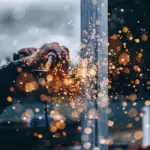The Pinglu Valley, located in Shanxi Province on the Loess Plateau of north-central China, is a testament to the dynamic forces shaping our planet. This tectonic trench, formed over millions of years, offers a fascinating glimpse into the processes of rift formation and the evolution of Earth’s surface.

The Birth of Pinglu Valley
Formation Through Tectonic Movements
Approximately 10 million years ago, the Pinglu Valley began to take shape as a result of movements deep within the Earth’s crust. The tectonic forces driving this transformation were primarily the separation of the Eurasian Plateau from the North China Block, causing the Earth’s surface to stretch and fracture.
Key Dimensions
The valley spans an impressive 10 kilometers in length, with a width of up to 2 kilometers and a depth reaching 100 meters. This striking topography is a hallmark of rift valleys, which are typically characterized by steep walls and flat floors created through tectonic stretching.
Geological Significance
Rift Valleys: A Rare Continental Phenomenon
While rift valleys are commonly found at the bottom of oceans, such as the Mid-Atlantic Ridge, their presence on continental surfaces is much rarer. The Pinglu Valley is part of a select group of such formations, making it an invaluable site for geological research.
Comparative Examples
Globally, some of the most notable rift valleys include:
- The Great Rift Valley System: Extending across eastern Africa, this formation includes the Jordan Trench and the Dead Sea, the lowest point on Earth’s surface.
- The Red Sea Trench: A continuation of the Great Rift, forming a boundary between the African and Arabian plates.
- Lake Baikal Rift: An underwater rift in Russia’s Lake Baikal, home to the deepest freshwater lake in the world.
- The Gulf of Corinth: Separating the Peloponnese Peninsula from mainland Greece.
- West Antarctic Rift: Hidden beneath thick ice sheets in Antarctica, this rift continues to intrigue scientists despite its inaccessibility.
The Loess Plateau and Its Role
A Unique Landscape
The Pinglu Valley is located within the Loess Plateau, a region known for its thick deposits of wind-blown silt and unique topography. The plateau’s rugged terrain and extensive erosion patterns have been shaped over millennia, providing a dramatic backdrop for the Pinglu Valley.
Geological Insights
This region is an important area for understanding tectonic activity in continental settings. The Loess Plateau’s sedimentary layers offer a historical record of climatic and tectonic changes that have occurred over millions of years.
Scientific Research and Exploration
Unlocking Earth’s Tectonic Secrets
Rift valleys like Pinglu are a focus of scientific inquiry, offering insights into:
- Tectonic Plate Movements: How and why the Earth’s crust fractures and stretches.
- Evolution of Landscapes: The processes shaping valleys, mountains, and basins over geological timescales.
- Seismic Activity: Understanding the risks associated with tectonic movements in populated areas.
Broader Implications
The study of rift valleys contributes to a deeper understanding of the Earth’s dynamic systems, aiding in everything from natural disaster prediction to the exploration of similar features on other planets, such as Mars’ Valles Marineris.
Like Us on Facebook!
Pinglu Valley: A Window to Earth’s Past
The Pinglu Valley serves as a living laboratory for geologists, historians, and nature enthusiasts alike. Its sheer size and dramatic landscape invite exploration, while its formation story connects us to the Earth’s ever-changing nature.
Subscribe Us on YouTube!
As one of the rare continental rift valleys, Pinglu stands among the ranks of the Great Rift Valley, the Red Sea Trench, and the Lake Baikal Rift. It is a geological marvel, helping to unravel the mysteries of tectonic forces that continue to shape our world.





















